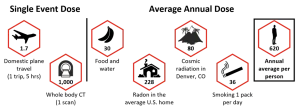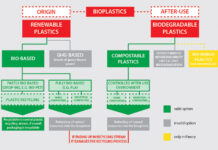Radiation is one of those words that, as it passes from the scientific to the general lexicon, loses all nuance. For those who can parse the electromagnetic spectrum, for example, it is no leap to recognize that while visible light and gamma rays are both types of radiation, the danger level between the two is significantly different. Yet, in great swaths of the general public, radiation tends to be a synonym for danger. There is little sense of scale or ability to differentiate radiation into categories, so it can be challenging to put that fear into perspective. Potential electron beam (EB) consumers have a myriad of backgrounds and may fall neatly in either camp or somewhere in between, so it is important to provide perspective through knowledge. Understanding the safety aspects of EB radiation not only fosters a sense of workplace safety and makes EB users better ambassadors of the technology, but it also allows consumers to make well-informed decisions as they consider transitioning away from less-green technologies.
Electron beam falls into a few different categories of radiation. First, accelerated electrons are considered ionizing radiation.1,2 This classification is based on the energy level of the electrons; accelerated electrons have sufficient energy to ionize molecules through the removal of a valence electron, which ultimately can lead to the breaking of chemical bonds within the molecule. Within the category of ionizing radiation, there are four types of radiation: alpha particles, beta particles, x-rays/gamma rays and neutrons.2,3 Accelerated electrons are beta radiation. Since exposure to ionizing radiation can be dangerous, a hallmark of each type is the distance the particles/waves can travel in different media: Alpha particles traveling least, with distance increasing for each subsequent type; and beta radiation can travel up to several feet through air but is stopped by a thin sheet of aluminum.
In addition to accelerated electrons, an electron beam also produces a small amount of secondary x-rays. When accelerated electrons interact with matter, particularly metal, the deceleration of electrons creates Bremsstrahlung (braking radiation) x-rays.2 Although it is estimated only about 2% of the EB energy generates x-rays, the x-ray radiation is one of the primary concerns when designing the safety shielding for a low-energy electron beam (≤ 300 kV) because of the much greater distance x-rays can travel as compared to accelerated electrons.
With an electron beam generating two types of ionizing radiation, how is it a safe technology? The short answer is containment. Low-energy EB equipment, such as that used in the production of flexible packaging or thin film cross-linking, is designed to be self-shielded. Ever wear a lead apron when getting x-rays taken at the dentist’s office? A self-shielded beam is essentially the reverse – the beam itself is wrapped in a slightly more sophisticated lead (and/or other dense metal) apron, which contains the radiation and protects the operator. Openings in the shielding required for material handling are engineered with multiple angles to attenuate the x-rays until they are at background level. In addition, dual redundant safety interlocks prevent any of the shielding from being opened while the beam is in operation.

The standard of radiation containment for these self-shielded EB systems is very high. The upper limit for PCT’s systems, for instance, is 0.1 mrem/hr (0.001mSv/hr) at 4 inches (10 cm) from any surface. Rem – roentgen equivalent man – and the SI equivalent, the sievert, are units of dose used when referencing human health effects resulting from exposure to low levels of ionizing radiation. To put a value of 0.1 mrem into perspective, Figure 1 lists average doses from common sources.4,5
For example, during a five-hour flight, a passenger will accumulate a dose exposure of 1.7 mrem (0.34 mrem/hr) – more than three times more than standing next to an EB! With 8,760 hrs in a year, a person living on (within four inches!) a running EB 24/7 would be exposed to 876 mrem – a bit more than the typical person’s annual average exposure, but still less than a single CT scan.
Another important bit of EB radiation safety knowledge is that the beam is generated using electricity, and there is no radiation present when the beam is turned off. Thus, when the beam is off, the shielding can be opened for access to the product web, maintenance to the beam, etc. This topic tends to arise when discussing EB sterilization, since an alternative method – gamma ray sterilization – uses a radioactive source (often 60Co).2 A radioactive source provides a few challenges, including continuous radiation, decay of the source and disposal of the source.
While EB systems are designed and built to be safe, there is a level of responsibility on the part of the user. After installation, it always is recommended that a third-party radiation survey be completed: Trained personnel use a Geiger counter to check for radiation leaks. While extremely rare, shifts in the shielding may occur during shipment if the beam is roughly handled, and a radiation survey ensures any such shift is caught. In addition, EB users must be sure to comply with state and/or country regulations.6 These regulations differ among regions but might include registering the beam, having a radiation survey completed and/or having an employee become a trained and certified radiation safety officer (RSO).
In summary, EB technology does produce ionizing radiation; however, self-shielded, low-energy electron beams are very effective in containing the hazard. Knowledge of the safety aspects of electron beam technology will reassure new users that they can harness the power of EB with confidence.
 Sage Schissel, Ph.D.
Sage Schissel, Ph.D.
Applications Specialist
PCT Ebeam and Integration LLC
sage.schissel@pctebi.com
References:
- Chapiro, A., Radiation Chemistry of Polymeric Systems. John Wiley & Sons, Inc.: New York, 1962.
- Makuuchi, K., Cheng, S., Radiation Processing of Polymer Materials and Its Industrial Applications. John Wiley & Sons, Inc.: New Jersey, 2012.
- Radiation in Everyday Life, International Atomic Energy Agency, https://www.iaea.org/Publications/Factsheets/English/radlife
- Report No. 160: Ionizing Radiation Exposure of the Population of the United States. United States Nuclear Regulatory Commission, National Council on Radiation Protection and Measurements, 2009.
- The 2007 Recommendations of the International Commission on Radiological Protection, Publication 103, Elsevier, 2007.
- Carignano, T., What are the Basic Regulatory and Safety Standards for the Installation of a Low-energy Electron Beam for Commercial Use. UV+EB Technology, 4, 2018.






